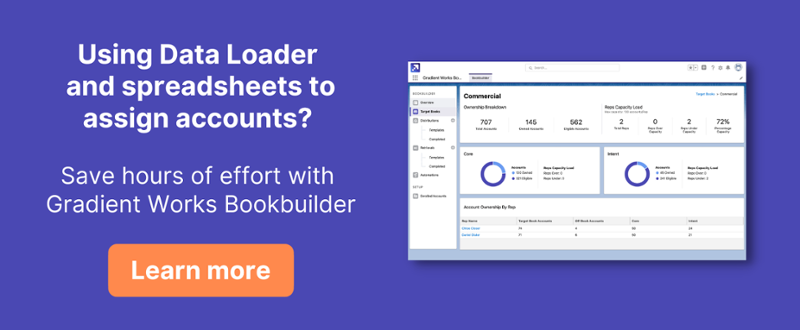We spend a lot of time on this blog talking about lead and opportunity distribution. But customer account assignment is every bit as important as lead assignment, if not more so.
Whether your post-sales organization is comprised of account managers, customer success managers, implementation specialists, onboarding consultants, or some combination of those, the long-term success of your customer relationships depends a great deal on who owns those relationships, and how that ownership is assigned throughout the customer lifecycle.
Customer account ownership matters
Who owns which customer accounts is closely connected to customer experience and ultimately, retention. How do you decide who owns which accounts in your customer success org? How do you keep your success rep books balanced? How do you assign new customers to your team?
We know that customer handoffs are important to a customer's satisfaction with your team and your product. And we usually focus on ensuring a smooth account handoff between new business and customer success. But what about the inevitable handoffs that happen after a customer has been assigned to a CSM or AM? For example, when an AM leaves your company or is promoted, all their accounts are reassigned to new AMs. Sometimes an unlucky customer gets reassigned a few times a year, as their AMs move around. And that's not counting intentional reallocations, like annual rep book balancing.
Many companies don’t think about automating account manager or customer success manager assignments because they just don’t have very many, at least not compared to the volume of inbound leads or sales operations they have. Even if you're already using an automated lead routing product for inbounds, you may rely on spreadsheets and managers doing manual work when it comes to customer teams.
But manual assignment processes are inconsistent and there’s a lot of room for error. Even seemingly simple judgment calls on which AMs and CSMs get which accounts will lead to varying results and book inequality over time. Even if you follow a clear round-robin assignment pattern, your reps may perceive the assignments as unfair. And manual processes don’t scale. What happens when you have twice as many customers next year?
Managing customer books
Your customer teams probably have a book of accounts that’s allocated (or reallocated) once a year. But AM books aren’t static - they’re going to change frequently as customers churn out, new customers are onboarded, and existing customers' needs change.
How do you determine which accounts are assigned to which reps? Do you rely on territories, market segments, ARR, or a simple round-robin? (We think you should move beyond territories in most cases, for what it's worth.) How do you ensure account distributions stay balanced between reps?
No matter how you do it, you need to divvy up rep books fairly. Capacity and load balancing are extremely important here. Ultimately, AM and CSM books will get out of balance over the course of the year. And if rep compensation is based on quota capacity and balanced books, then you’re risking compensation inequality and very unhappy employees.
Onboarding impacts retention in a big way
A new customer's onboarding experience has a huge impact on everything that comes after, including that customer's likelihood of renewing their contract with your company.
So if your onboarding experience is slow or confusing, your customer may not be your customer for very long. Onboarding is directly related to customer experience, so the smoother the onboarding, the better the customer experience. How do you assign implementation or onboarding reps? How long do new customers have to wait to get started? How do you balance onboarding rep capacity?
ChurnZero has some good onboarding tips, but it really comes down to increasing a customer's time-to-value. Speed becomes important in onboarding - you need to get customers up and running with your product as quickly as you can. What can you do first to ensure your customer is getting value from your product immediately? Think carefully about your onboarding process, and don't skimp on resources dedicated to this part of the customer lifecycle.
How do you think about customer account assignment?
If you don't already automate the assignment of onboarding reps, CSMs, and AMs, you may want to take a look at what we can do with Gradient Works. Our routing and assignment product can optimize your customer team assignments, saving you and your customers time, and increasing their time-to-value. Let us know if you'd like a demo!





